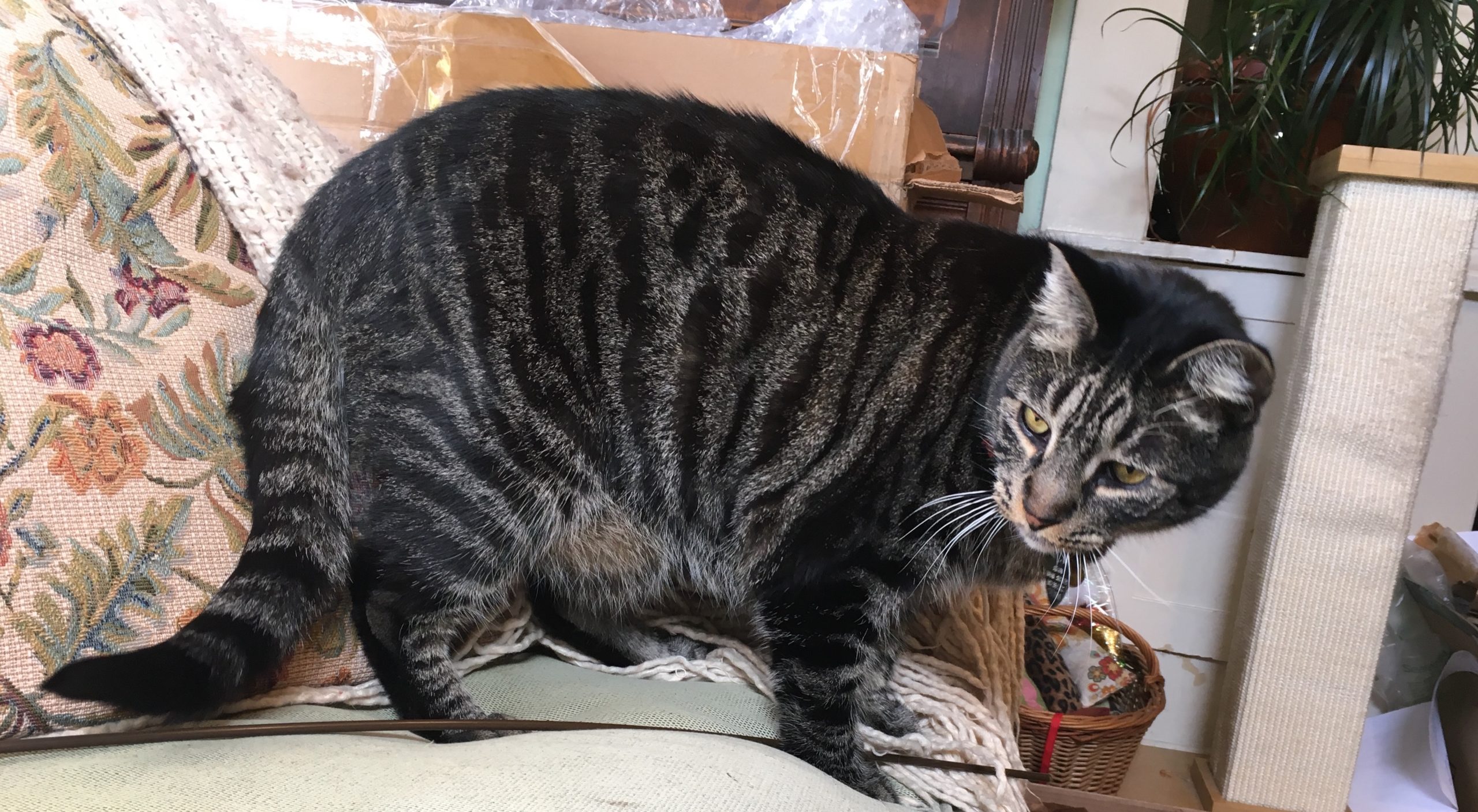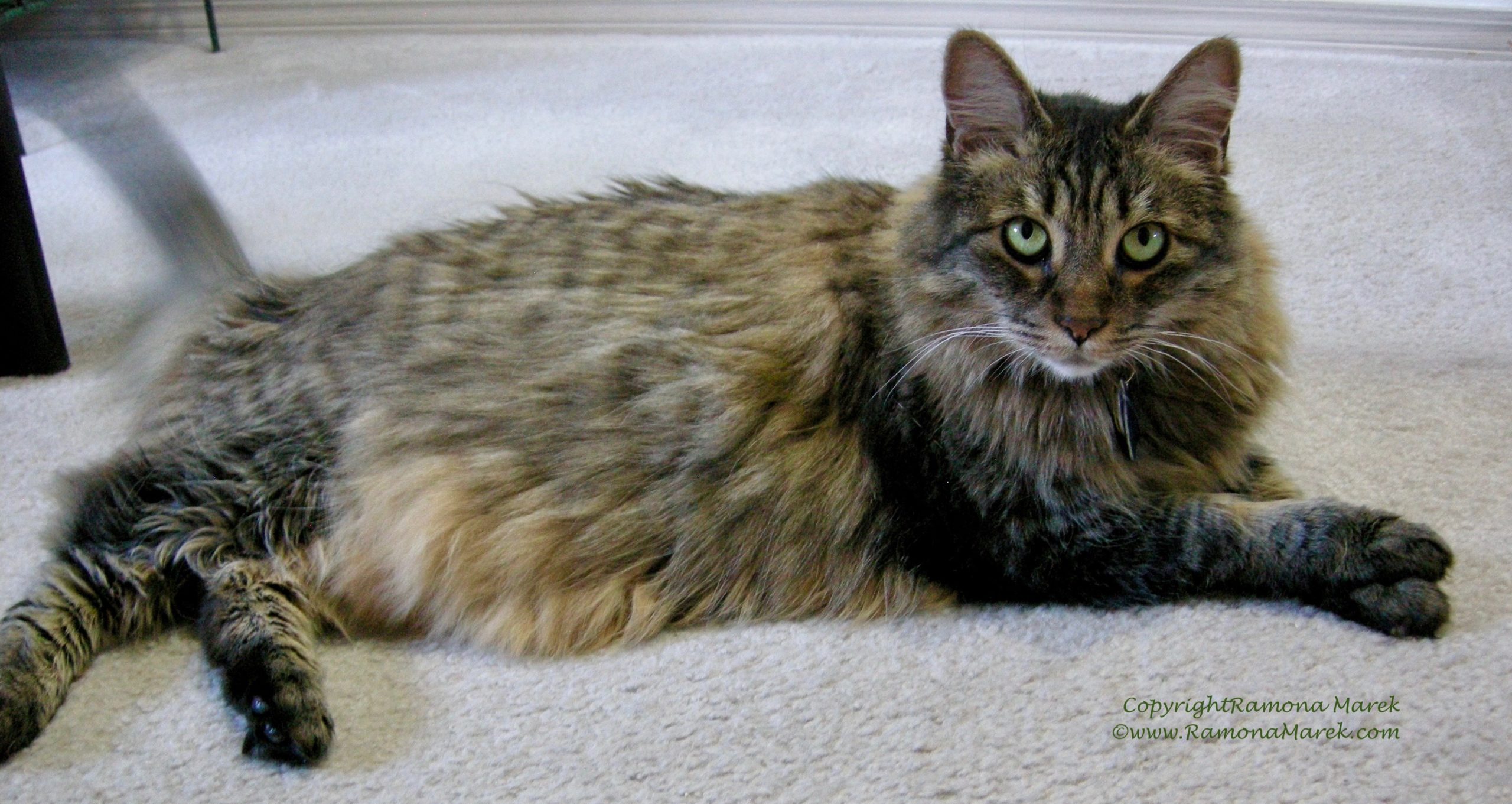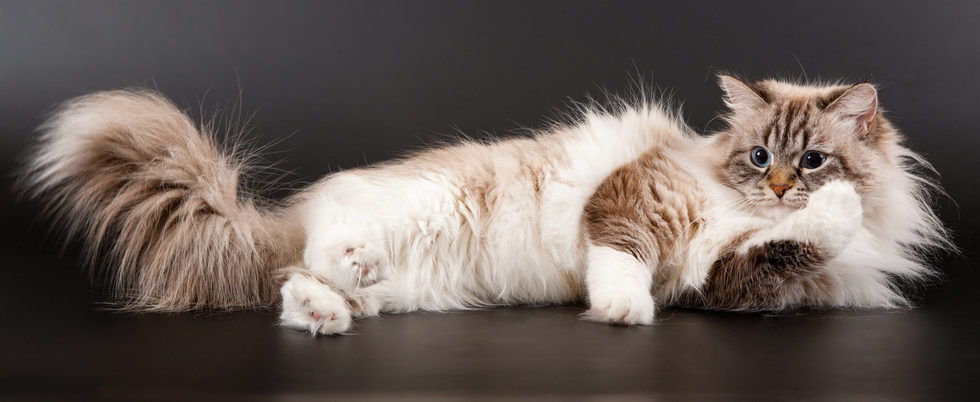At 12 weeks old, Ivan was a bear of a kitten, hinting at his full adult Siberian size. He had the most adorable baby fat paunch I took as a sign that the husky boy never missed a chance to belly up to the milk bar.
We adopted Natasha from our shelter the day after she was spayed. She developed a “spay-sway” so low and prominent that I sing “Swing Low Sweet Chariot” when she runs. I considered it an accessory to her Rubenesque figure.
I was wrong on both counts.
Primordial Pouch
Called many names–belly pouch, belly flap, spay-sway, abdominal fold–the feline primordial pouch has nothing to do with a cat being overweight or a hanging belly apron as a result being spayed or neutered.
 The primordial pouch is a flap of skin on a cat’s belly that runs the length of the abdomen. It’s easily seen near the back legs. The pouch sways from side to side as the cat walks. The area feels like soft gelatin in a plastic baggie. It’s a natural part of the feline anatomy which all cats have although the size and appearance varies. Even big cats such as lions and tigers have it.
The primordial pouch is a flap of skin on a cat’s belly that runs the length of the abdomen. It’s easily seen near the back legs. The pouch sways from side to side as the cat walks. The area feels like soft gelatin in a plastic baggie. It’s a natural part of the feline anatomy which all cats have although the size and appearance varies. Even big cats such as lions and tigers have it.
Theorized Purposes
Experts have several theories about the purpose of the primordial pouch. The loose skin flap has an elastic quality, and certain conditions such as weight loss and aging may make the pouch more noticeable. On some breeds, such as the Bengal, the primordial pouch may be more distinct.
“Here’s the thing. The Bengal standard says nothing about a pouch. Nothing. But people talk about it. All cats have them; just some more than others and, like humans, they sag as they get older,” says Teresa Keiger, a Cat Fanciers’ Association all-breed judge.
Most animals have a fat layer covering their abdomen to protect their organs, and that includes cats. During fights or rough play such as bunny kicking, the padded pouch protects the belly from injury caused by sharp claws on the rear paws. “What I find more fascinating than the primordial pouch is the fact that the cat evolved the bigger defense mechanism of not having its skin attached to its musculature. Queens can pick up and move kittens, they became more flexible in a twisty-turn-y way, and it can help protect organs,” says Keiger.
kicking, the padded pouch protects the belly from injury caused by sharp claws on the rear paws. “What I find more fascinating than the primordial pouch is the fact that the cat evolved the bigger defense mechanism of not having its skin attached to its musculature. Queens can pick up and move kittens, they became more flexible in a twisty-turn-y way, and it can help protect organs,” says Keiger.
The exceptional elasticity is key to feline form and function. The primordial pouch stretches like feline elastane (Lycra, Spandex), allowing the cat to fully stretch out in full stride when running, leaping or jumping. “My father always called it ‘jumping skin,’ so the speculation has been around awhile,” says Alice Moon-Fanelli, PhD, CAAB, of Animal Behavior Consultations, LLC.
The third supposition is that it’s a throwback to wild feline forefathers gorging after a kill, not knowing when their next meal would be. The thought is that the pouch expands, allowing more room for storage of the large meal, like a feline version of wearing sweat pants to an all-you-can-eat buffet. “The cat evolved to subsist and make the most of very little. Saving energy stored as fat is brilliant; most animals do that to some degree–looking at you, hibernating bear,” says Keiger.
Weighty Issue
The primordial pouch has a fatty texture, but that in itself does not mean your cat is overweight. Obesity is a serious health threat and approximately 60 percent of cats are overweight or obese, according to the Association for Pet Obesity Prevention.
How can you tell the difference between the primordial pouch and an overweight cat? The primordial pouch is loose, hangs low, and sways when the cat walks. For a normal weight cat, you should feel your cat’s ribs, you should see a “waist” behind the ribs and only a minimal fat pad. Looking at your cat from above you should see a feline version of the hourglass shape. In overweight and obese cats, you won’t feel the ribs, the stomach is rounder and a bit firmer, and doesn’t sway when the cat walks.
Talk to your veterinarian about the ideal weight for your cat and work together to develop a weight management plan. “An overweight cat is an overweight cat, pouch or none,” says Dr. Moon-Fanelli. “Weight, rib palpation, etc. should indicate whether or not the cat is fat. I’d ignore the pouch and focus on the weight and musculature.”
The feline primordial pouch is a normal part of your cat’s anatomy and nothing to be concerned about. The bigger concern is keeping your cat active, at a healthy weight, and happy.
This article was reviewed/edited by board-certified veterinary behaviorist Dr. Kenneth Martin and/or veterinary technician specialist in behavior Debbie Martin, LVT.








